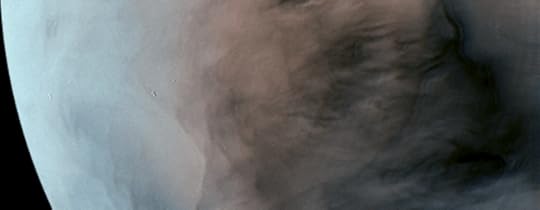Elizabeth Tasker's Blog
February 13, 2022
Can We Trust a Handful of Grains to Tell Us About the Early Earth? A Look at the Hayabusa2 Asteroid Sample

The Hayabusa2 sample return capsule returning to Earth. The bright streak in the sky is the capsule, shock heated as it enters the Earth’s atmosphere. The bright lights on the ground are buildings. (JAXA)
In the early hours of December 6, 2020, what appeared to be a shooting star blazed across the sky above the Woomera desert in South Australia. The source was the sample return capsule from JAXA’s Hayabusa2 mission, which contained precious material from a near-Earth asteroid known as...
July 7, 2021
The Surface of Venus Was Thought to Be Stagnant. But This May Not Be True
 An oblique radar view of the largest “pack ice” block in the Venus lowlands identified by Byrne et al. (Paul Byrne, based on original NASA/JPL imagery).
An oblique radar view of the largest “pack ice” block in the Venus lowlands identified by Byrne et al. (Paul Byrne, based on original NASA/JPL imagery).The two Earth-sized planets in our solar system have taken wildly different evolutionary routes. The surface of the Earth became a temperate utopia for a liquid water and a myriad of life. But while similar in both size and mass, the surface of the neighboring Venus is hot enough to melt lead.
These differences are the key to understanding...
June 14, 2021
And Then There Were Three: ESA Follows NASA in Selecting a Mission to Venus
 Artist illustration of the EnVision orbiter at Venus (ESA/VR2Planets/DamiaBouic)
Artist illustration of the EnVision orbiter at Venus (ESA/VR2Planets/DamiaBouic)It was quite a week for Venus scientists. Just seven days after NASA announced the selection of two Venus missions, DAVINCI+ and VERITAS, the European Space Agency (ESA) revealed that a third Venus mission had been chosen for the agency’s medium-class mission category.
(See last week’s post here on Many Worlds about DAVINCI+ and VERITAS)
The new mission is named EnVision, and will be ESA’s second Venus miss...
June 7, 2021
Return to Hell: NASA Selects Two Missions to Venus to Explore the Pathway to Habitability
 Artists’ renderings show the VERITAS spacecraft (left) and DAVINCI+ probe (right) as they arrive at Venus (Lockheed Martin).
Artists’ renderings show the VERITAS spacecraft (left) and DAVINCI+ probe (right) as they arrive at Venus (Lockheed Martin).For NASA scientists, Venus missions must feel like buses. You wait thirty years for one, and then two come along at once.
Last week, NASA selected two Venus missions for the space agency’s Discovery Program; solar system exploration missions that can tuck under a lower cost cap than candidates for NASA’s New Horizons or Flagship categories. The first of these is DAVI...
February 23, 2021
The Directly Imaged World Around α Centauri?
 Optical and X-ray (cut-out) image of the Alpha Centauri binary stars (Optical: Zdenek Bardon; X-ray: NASA/CXC/Univ. of Colorado/T. Ayres et al.)
Optical and X-ray (cut-out) image of the Alpha Centauri binary stars (Optical: Zdenek Bardon; X-ray: NASA/CXC/Univ. of Colorado/T. Ayres et al.)There is something terribly exciting about actually seeing an exoplanet. While we have discovered over 4,000 planets outside the solar system, the majority of these worlds have been identified through their influence on their star, either via a dimming of the star’s light as the planet transits across its surface, or the wobble of the star from the p...
The Directly Imaged World Around α Centauri
 Optical and X-ray (cut-out) image of the Alpha Centauri binary stars (Optical: Zdenek Bardon; X-ray: NASA/CXC/Univ. of Colorado/T. Ayres et al.)
Optical and X-ray (cut-out) image of the Alpha Centauri binary stars (Optical: Zdenek Bardon; X-ray: NASA/CXC/Univ. of Colorado/T. Ayres et al.)There is something terribly exciting about actually seeing an exoplanet. While we have discovered over 4,000 planets outside the solar system, the majority of these worlds have been identified through their influence on their star, either via a dimming of the star’s light as the planet transits across its surface, or the wobble of the star from the p...
December 11, 2020
Japan’s Hayabusa2 Mission Returns to Earth
 Fireball created by the Hayabusa2 re-entry capsule as it passes through the Earths atmosphere towards the ground (JAXA).
Fireball created by the Hayabusa2 re-entry capsule as it passes through the Earths atmosphere towards the ground (JAXA). In the mission control room in Japan, all eyes were fixed on one of the large screens that ran along the far wall. The display showed the night sky, with stars twinkling in the blackness. We were waiting for a delivery from space.
Japans Hayabusa2 mission launched from the Tanegashima Space Center on December 3, 2014. The spacecraft was headed to asteroid Ryugu, with the...
September 28, 2020
The Planet Larger Than Its Star
It has been an exciting month for planets. Just days after the announcement of a detection of phosphine in the clouds of Venus, another first in planet discoveries was declared. The new find is the first planet observe...
September 14, 2020
Could Life Exist in the Clouds of Venus?
 Nightside of Venus captured with the IR2 (infrared) camera on JAXA’s Akatsuki climate orbiter (JAXA).
Nightside of Venus captured with the IR2 (infrared) camera on JAXA’s Akatsuki climate orbiter (JAXA).On September 14 at 3pm GMT, an embargo lifted on a research paper reporting evidence for biological activity on Venus. Speculation about the discovery had been spreading rapidly through social media for several days, proving that scientists are incapable of keeping secrets.
With a surface temperature sufficient to melt lead, Venus is not the usual candidate for extraterrestrial life. Howev...
May 14, 2020
Standing on an Asteroid: Could the Future of Research and Education be Virtual Reality?
Have you ever wondered what it would be like to stand on an asteroid? A rugged terrain of boulders and craters beneath your feed, while the airless sky above you opens onto the star-spangled blackness of space.
It sounds like the opening scene for a science...



